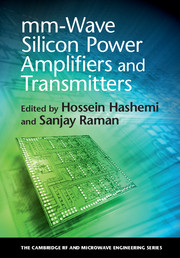Book contents
- Frontmatter
- Contents
- List of Contributors
- Preface
- 1 Introduction
- 2 Characteristics, performance, modeling, and reliability of SiGe HBT technologies for mm-wave power amplifiers
- 3 Characteristics, performance, modeling, and reliability of CMOS technologies for mm-wave power amplifiers
- 4 Linear-mode mm-wave silicon power amplifiers
- 5 Switch-mode mm-wave silicon power amplifiers
- 6 Stacked-transistor mm-wave power amplifiers
- 7 On-chip power-combining techniques for mm-wave silicon power amplifiers
- 8 Outphasing mm-wave silicon transmitters
- 9 Digital mm-wave silicon transmitters
- 10 System-on-a-chip mm-wave silicon transmitters
- 11 Self-healing for silicon-based mm-wave power amplifiers
- Index
- References
9 - Digital mm-wave silicon transmitters
Published online by Cambridge University Press: 05 April 2016
- Frontmatter
- Contents
- List of Contributors
- Preface
- 1 Introduction
- 2 Characteristics, performance, modeling, and reliability of SiGe HBT technologies for mm-wave power amplifiers
- 3 Characteristics, performance, modeling, and reliability of CMOS technologies for mm-wave power amplifiers
- 4 Linear-mode mm-wave silicon power amplifiers
- 5 Switch-mode mm-wave silicon power amplifiers
- 6 Stacked-transistor mm-wave power amplifiers
- 7 On-chip power-combining techniques for mm-wave silicon power amplifiers
- 8 Outphasing mm-wave silicon transmitters
- 9 Digital mm-wave silicon transmitters
- 10 System-on-a-chip mm-wave silicon transmitters
- 11 Self-healing for silicon-based mm-wave power amplifiers
- Index
- References
Summary
Motivation
As tablets and smartphones have become the main drivers for high-data-rate wireless communications, bandwidth demand and energy efficiency have also emerged as major concerns in wired and fiber-optic data-center and last-mile links. Energy consumption is particularly poor in wireless links and typically exceeds 500 pJ/bit. Since the transmit power amplifier in most wireless devices radiates 500 mW or higher, its energy efficiency can be improved significantly by switching it off and on in deep saturation at tens of Gb/s. Additionally, the output power and power consumption of the entire transmitter must be scalable with the data rate and with the link range.
In a conventional transmitter, shown in Fig. 9.1, the in-phase (I) and quadrature-phase (Q) baseband data bits are converted to an analog signal at baseband, filtered, and then up-converted to the RF carrier. This signal is amplified by the PA, which either directly drives the antenna or drives another filter to limit emissions at harmonics of the carrier. The baseband clock is either Nyquist rate or oversampled by a modest factor, depending on how much signal processing (filtering) is performed in the digital domain. The role of the baseband filter is critical in this architecture as it smooths the data transitions, attenuating the spectral images of the signal. The I and Q signals traverse the constellation points of the modulation scheme, and need to be processed appropriately to minimize distortion (which leads to EVM degradation). This single-sideband radio transmitter architecture is versatile, transparent to the modulation scheme, and makes the most efficient use of the available bandwidth. However, for modulation formats that involve different amplitude levels, such as 16QAM and 64QAM, this architecture imposes very stringent linearity constraints on the up-converter and on the entire mm-wave path which are increasingly difficult to satisfy at multi-gigabit per second data rates. Furthermore, once the I and Q signals are combined, most spectrally efficient modulation schemes generate a signal with envelope variation, which requires the power amplifier to be linear. For example, to avoid degradation of the 16QAM signal (e.g. EVM increase and spectral regrowth) the power amplifier is typically backed-off by up to 6 dB from its 1-dB output compression point. Because it exhibits a quadratic efficiency loss with back-off, if a class-A PA is employed the efficiency drops by a factor of 4.
- Type
- Chapter
- Information
- mm-Wave Silicon Power Amplifiers and Transmitters , pp. 334 - 375Publisher: Cambridge University PressPrint publication year: 2016
References
- 4
- Cited by

